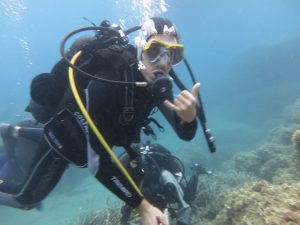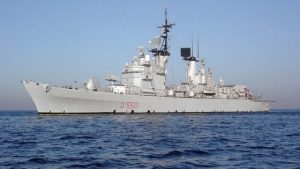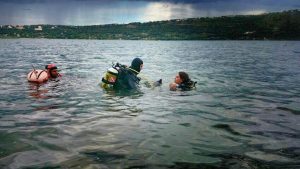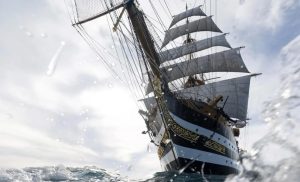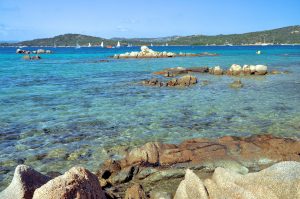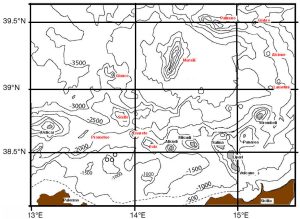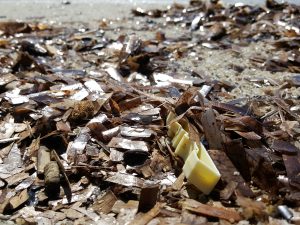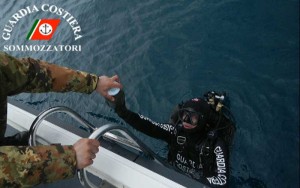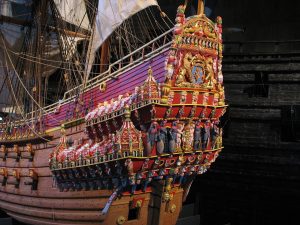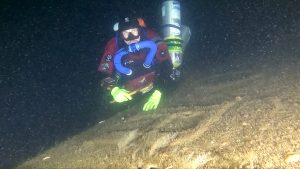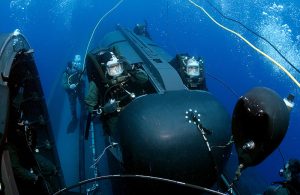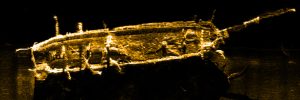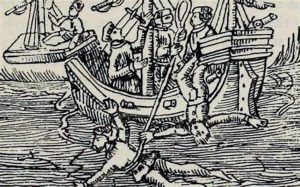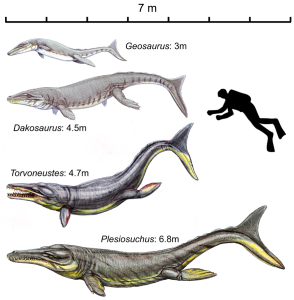.
livello medio
.
ARGOMENTO: BIOLOGIA MARINA
PERIODO: XXI SECOLO
AREA: RICERCA
parole chiave: nudibranchi
Article originally published in Scientia Marina · January 2017
DOI: 10.3989/scimar.04479.09A
Giulia Furfaro 1, Paolo Mariottini 1, Maria Vittoria Modica 2, Egidio Trainito 3, Mauro Doneddu 4, Marco Oliverio 2
1 Dipartimento di Scienze, Università “Roma Tre”, Viale G. Marconi 446, I-00146 Rome, Italy. E-mail: giulia.furfaro@uniroma3.it
2 Dipartimento di Biologia e Biotecnologie “Charles Darwin”, Università di Roma “La Sapienza”, Viale dell’Università 32, I-00185 Rome, Italy.
3 Villaggio I Fari, Loiri Porto San Paolo, I-07020 Olbia-Tempio, Italy.
4 Via Palau, 5 I-07029 Tempio Pausania, Italy.
Summary: The aeolid nudibranch Caloria elegans (Facelinidae) is quite common in the Mediterranean Sea and eastern Atlantic Ocean and is easily recognized by the presence of a typical black spot at the apical portion of its cerata. Facelina quatrefagesi (Facelinidae) was long considered as a synonym of C. elegans until recently, when it was re-evaluated as a valid species based mainly on rhinophore morphology. In order to definitively assess the status of these aeolid taxa, we employed an integrative taxonomy approach using the nuclear H3 and the two mitochondrial cytochrome oxidase subunit I and 16S markers. The molecular analyses clearly showed that, although morphologically closely related to C. elegans, F. quatrefagesi is a valid species.
Keywords: integrative taxonomy; molluscs; Facelinidae; systematics; phylogeny.
Citation/Como citar este artículo: Furfaro G., Mariottini P., Modica M.V., Trainito E., Doneddu M., Oliverio M. 2016. Sympatric sibling species: the case of Caloria elegans and Facelina quatrefagesi (Gastropoda: Nudibranchia). Sci. Mar. 80(4): 000-000. doi: http://dx.doi.org/10.3989/scimar.04479.09A
Editor: J. Viñas. Received: May 17, 2016. Accepted: October 17, 2016. Published: November 9, 2016.
Copyright: © 2016 CSIC. This is an open-access article distributed under the terms of the Creative Commons Attribution (CC-by) Spain 3.0 License.
INTRODUCTION
Caloria elegans (Alder and Hancock, 1845) is a nudibranch belonging to the family Facelinidae Bergh, 1889. The genus Caloria was erected by Trinchese (1888) with the description of Caloria maculata that is currently accepted (Gofas 2015) as a synonym of Caloria elegans Alder and Hancock, 1845 (Sartori and Go- fas 2014). The original description of C. maculata by Trinchese (1888) is very detailed but it lacks the figure of the entire animal. The rhinophores are described in the text in two sections: “I rinofori a sezione trasversa circolare, sparsi di lievi ripiegature, ma non perfoliati.” (The rhinophores have a circular transverse section and scattered slight folds, but they are not perfoliate) (p. 291); and “I rinofori sottili, bianco-trasparenti, presentano delle rughe irregolari. Una striscia bianco- opaca si estende sulla faccia anteriore dei loro due terzi superiori.” (The thin rhinophores, white transparent, show some irregular wrinkles. A white-matt strip on their anterior side extends to the upper two-third) (p. 292).
Fig. 1. – Caloria elegans morphological variability. A, original drawing from the redescription by Alder and Hancock (1845). B, drawing of the North Atlantic specimen (Picton, 1979)
These descriptions fit rhinophores possessing wrinkles or slight folds, but not lamellae, and they can be considered equivalent to the ones described for Eolis elegans by Alder and Hancock (1845, 1851). The latter authors, while redescribing the species (1851) clearly depicted the rhinophores (i.e. dorsal tentacles) as “of moderate length, stoutish, erect, tapering at the top and wrinkled transversely, of a pale fawn colour or buff, with a streak of white in front near the apex.” In this case, “wrinkled transversely” clearly indicates that they are not lamellate rhinophores, and in the depicted animal (1851: pl. 17, figs 2, 3) these wrinkles are very evident (Fig. 1A). Picton (1979) traced back the systematic history of C. elegans, redescribing this taxon with specimens from the Bristol Channel (UK) and considering C. maculata as its junior synonym. In the redescription, the rhinophores are not reported as lamellate (“Posterior surfaces of rhinophores cov- ered with small irregularly distributed papillae”) and this character is clearly depicted in his figures (Picton 1979: figs 1A, B) (Fig. 1B). Later, Schmekel and Portmann (1982) described C. elegans, referring to its rinophores as “cylindrical and smooth”. This diversity in C. elegans rhinophores surface (smooth, wrinkled or papillate) was related by Thompson (1988) to the particular ontogenetic stage of the specimens and not to a typical diagnostic feature of the species. In fact, he wrote “The fawn coloured rhinophores… the rear surfaces … are in the adult specimens covered with small, irregularly distributed papillae (hard to detect or absent in the juveniles)”. This issue has been also briefly noticed by Cattaneo-Vietti et al. (1990): “rinofori che possono essere lisci o finemente papillati” (rhinofores can be smooth or finely papillated).
Another taxon synonymized with C. elegans is Acanthopsole quatrefagesi Vayssière, 1888, described based on specimens from the Mediterranean Sea, Villefranche-Sur-Mer (France), which was included in the genus Facelina Alder and Hancock, 1855 by Pruvot-Fol (1951). In 1888 Vayssière described A. quatrefagesi with recently preserved samples but no figures of the whole animal or the rhinophores. The original description (Vayssière 1888: plate VII, figs 137-143) includes cerata, penis, jaws and radular teeth.
Facelina quatrefagesi was described as showing lamellate rhinophores: “Les rhinophores, moins longs que les tentacules labiaux, possédaient del lamelles olfactives transversales perpendiculaires, sortes d’anneaux sur les deux tiers supérieurs de leur longueur.” (The rhinophores, shorter than the labial tentacles, possessed perpendicular transverse olfactory lamellae, kinds of rings on the upper two-thirds of their length). The shape of the rhinophores is routinely used as a diagnostic character in almost all other nudibranchs. Based on this feature, F. quatrefagesi should not be considered as a synonym of C. elegans, as proposed by Picton (1979) and accepted in successive papers (Cattaneo and Barletta 1984, Sabelli et al. 1990).
Recently, Trainito and Doneddu (2014) proposed F. quatrefagesi and C. elegans as separate species, mostly considering the morphology of their rhinophores. According to these authors, these two species often show very similar chromatic patterns (Fig. 2), and although some pigmentation differences can be observed (Trainito and Doneddu 2014: 106), their separation is mainly based on the rhinophore morphology, lamellate in F. quatrefagesi and smooth or papillated in C. elegans (Fig. 2). These authors also specified that F. quatrefagesi is very constant in colour, while C. elegans displays a certain degree of variability (Fig. 2A, B).
Fig. 2. – Underwater photographs showing the in situ individuals of C. elegans (A, B) and F. quatrefagesi (C, D). A, Lavezzi (41.341559°N 9.246254°E) Bonifacio, Corse, France, 8 m depth, 23/03/2013; length 10 mm. B, Capo Figari (40.994595°N 9.664622°E), Golfo Aranci, Italy, 12 m depth, 14/10/2013; length 10 mm. C, Lido del Sole (40.914482°N 9.566886°N), Olbia, Italy, 4 m depth, 05/11/2012; length 20 mm. D, Punta Saline (40.915168° N 9.576346°N) , Olbia, Italy, 5 m depth, 21/05/2014; length 20 mm.
In order to definitively assess the taxonomy of these two nominal species, individuals from different Tyrrhenian localities (Western Mediterranean Sea) were sampled and investigated with an integrative taxonomy approach using both anatomical and molecular methods aimed at increasing the robustness of species delimitation (Modica et al. 2014).
The mitochondrial cytochrome oxidase sub-unit I (COI) marker is routinely used for species delimitation analyses and is now considered a very useful barcoding marker for molluscs in general (Furfaro et al. 2016b), due to its fast-evolving rate of mutation. The partial 16S marker is a non-coding mitochondrial gene that shows the capability to fold in a 2D secondary structure that could be diagnostic for species delimitation (Lydeard et al. 2000, Salvi et al. 2010, Salvi et al. 2014) and as an additional tool for phylogenetic analyses. The H3 is a nuclear gene characterized by a slow evolving rate (Padula et al. 2016) and it is commonly used to explore the relationships occurring within higher taxonomic levels. We used partial sequences of two mitochondrial (COI and 16S rDNA) and one nuclear marker (histone H3), newly produced and retrieved from GenBank to clarify species boundaries between the two taxa under study.
MATERIALS AND METHODS
Samples were collected by SCUBA diving at Mediterranean and Atlantic localities. Specimen data, including collection localities, accession numbers and references, are reported in Table 1. Vouchers are stored at the Department of Biology and Biotechnologies, ‘La Sapienza’ University (Rome, Italy) (Table 1). Hundreds of individuals were observed in situ or indirectly by photographs. Sequences from 13 individuals (ascribed to the family Facelinidae and the outgroup) were used for the molecular analyses.

.
Morphological analyses
Samples were observed and photographed with both optical and scanning electronical microscope (SEM) techniques. External morphological features were observed and recorded for both ‘lamellated’ and ‘smooth-papillate’ samples. The buccal apparatus (radulae and jaws) was observed in both species (Fig. 3A-D). Buccal masses were placed in a 10% NaOH solution to isolate the radulae and the jaws, which were then dehydrated to 100% ethanol, critical point-dried, gold-coated in an Emitech K550 unit, and examined by a Dualbeam SEM Helios Nanolab (FEI Company, Eindhoven, the Netherlands) at the LIME (Electron Microscopy Interdepartmental Laboratory, Roma Tre University, Rome, Italy), with secondary electrons and an operating voltage of 5 kV (for a more detailed description see Furfaro et al. 2016a). The reproductive system of both species (at least two samples per taxon) was examined using standard dissecting procedure and synthetically drawn in semi-schematic depictions (Fig. 3E, F).
Molecular analyses
A piece of tissue was dissected from the foot of 13 specimens for DNA extraction. Total genomic DNA was extracted using a standard proteinase K phenol/ chloroform method with ethanol precipitation, as reported in Oliverio and Mariottini (2001). Partial sequences of three different molecular markers, the nuclear Histon 3 (H3) and the mitochondrial 16S rDNA (16S) and COI were amplified by polymerase chain reaction (PCR) [H3 primers (Colgan et al. 1998), 16S primers (Palumbi et al. 1991) and COI primers (Folmer et al. 1994)] and PCR conditions as described in Prkić et al. (2014). Amplicons were sequenced by European Division of Macrogen Inc. (Amsterdam, The Netherlands), using both primers used in the amplification reaction. Sequences obtained were edited with Staden Package 2.0.0b9 (Staden et al. 2000). A BLASTN (Altschul et al. 1990) search was conducted in the Gen-Bank database to confirm the identity of the sequenced fragment and to exclude contamination. Uncorrected genetic distances (p-distance) and genetic distance estimated under a Kimura-2-parameter nucleotide substitution model (K2p) were calculated with MEGA V 6.0 (Tamura et al. 2013).
Tritonia striata Haefelfinger, 1963 was used as the outgroup because of its basal placement within Cladobranchia following Pola and Gosliner (2010).
For COI, the Automatic Barcode Gap Discovery (ABGD, available at http://wwwabi.snv.jussieu.fr/public/abgd/) was employed to detect the so called “barcode gap” in the distribution of pairwise distances calculated for a sequence alignment (Puillandre et al. 2012a, b). Alignments from the supposedly fast-evolving COI (excluding the outgroup) were analysed in ABGD using either p-distance or the K2p nucleotide substitution model and the following settings: a prior for the maximum value of intraspecific divergence between 0.001 and 0.1, 30 recursive steps within the primary partitions de- fined by the first estimated gap, and a gap width of 0.1.
Fig. 3. – Buccal apparatus of C. elegans (A-B) and F. quatrefagesi (C-D). A, C, detail of the jaw denticles. B, D, detail of the rachidian tooth of the radula. Bar scale 50 µm. E, F, schematic drawing of the reproductive systems of C. elegans (E) and F. quatrefagesi (F) respectively. Abbreviations: am, ampulla; fgl, female gland; p, penis; pr, prostate; rs, seminal receptacle; vd, vaginal duct. Scale bar 200 µm.
Sequences obtained for each individual were aligned by Muscle, MEGA V 6.0 (Tamura et al. 2013), resulting in 3 alignments for H3, 16S rDNA and COI, respectively 294, 420 and 588 bp long. The best fitting substitution model was selected for each alignment by the Bayesian information criterion implemented in JModel Test 0.1 package (Posada 2008).
Two different concatenated and partitioned datasets were built with DnaSP ver.5.10.01 (Librado and Rozas 2009): the first included all nuclear and mitochondrial markers, while the second was reduced to the mitochondrial 16S and COI markers only. The variable sites of the resulting mitochondrial and nuclear concatenated alignment were individuated using DnaSP ver. 5.10.01 (Librado and Rozas 2009). Maximum likelihood (ML) analysis (bootstrapped over 1000 replicates) and Bayesian inference (BI) (with 5´106 generations, and 25% burnin) were performed for both single genes and a concatenated dataset using RAx- ML V. 8 (Stamatakis 2014) run on the Cypres platform (Miller et al. 2010) and MrBayes 3.2.2 (Ronquist et al. 2011) to infer the phylogenetic relationships among the aligned sequences. Nodes in the resulting phylogenetic trees with Bayesian posterior probabilities (Bpp) ³0.96% and bootstrap values (Bs) ³90% were considered ‘highly’ supported; nodes with Bpp of 0.90-0.95% and Bs of 80-89% were considered ‘moderately’ supported (lower support values were considered not significant) as in Furfaro et al. (2014, 2016a, b). The 16S RNA secondary structures were obtained contrasting several candidate low free-energy folding models calculated using the mfold Web Server [http://unafold.rna.albany.edu/?q=m– fold/RNA-Folding-Form (Zuker 2003)] and 4SALE 1.7 (Seibel et al. 2006, 2008).
RESULTS
Microscopical observations of the radulae and jaws (Fig. 3A, D) from specimens of C. elegans and F. quatrefagesi revealed no noteworthy differences. All the radulae observed had formula (0.1.0.)×20 and were very similar to each other in the rachidian tooth (Fig. 3B-D) and also in the denticulated jaws (Fig. 3A, C). The reproductive systems showed differences in the length of the ampulla duct and in the shape of the terminal portions of the prostate. In particular, the ampulla of C. elegans specimens was connected through a duct shorter than that of F. quatrefagesi. Furthermore, the prostatic portion of the C. elegans reproductive system had a constriction before the deferent duct, while it expanded gradually into the vas deferens in F. quatrefagesi (Fig. 3E, F). No other major differences were observed. Cerata of both species possess an apical portion, right behind the typical black spot, which is contractile and may lead to specimens showing cerata with different lengths. This characteristic is visible in Picton’s drawing (1979) and was also recognized in specimens observed in vivo during this study.
Stereomicroscope observations on the rhinophores of C. elegans specimens revealed that, according to their stretching, they can appear i) smooth when elongated to their maximum length (Fig. 4A); ii) with clearly visible papillae when slightly contracted (compare Fig. 4B with Fig. 1B); or iii) markedly wrinkled when considerably contracted (compare Fig. 4C with Fig. 1B). Molecular analyses yielded 32 new sequences, which were added to the 34 sequences retrieved from GenBank (Table 1). The complete dataset consisted of
Fig. 4. – Rhinophore morphology of C. elegans (A-C) and F. quatrefagesi (D). A, B, extended rhinophores; C, contracted rhinophores. D, detail of the lamellate rhinophore of F. quatrefagesi.
Fig. 5. – Phylogenetic relationships among facelinid species based on Bayesian analysis of the partitioned (H3, COI and 16S) combined dataset. Numbers at nodes are Bayesian posterior probability and ML bootstrap support, respectively. The histogram shows the distribution of the pairwise estimated genetic distances (K2p) in intraspecific (light grey, left) and interspecific (dark grey, right) comparisons.
Table 2. – Mean distance between groups on the barcode marker COI (p-distance method).
| Caloria elegans | Facelina quatrefagesi | Caloria indica | Caloria sp. | |
| Caloria elegans | – | |||
| Facelina quatrefagesi | 0.145 | – | ||
| Caloria indica | 0.197 | 0.201 | – | |
| Caloria sp. | 0.197 | 0.192 | 0.221 | – |
66 sequences (15 for the nuclear H3, 18 for the mi- tochondrial 16S and 21 for the COI barcode marker) obtained from 22 specimens (including the outgroup). The H3 (=294 bp), 16S (=420 bp) and COI (=588 bp) concatenated alignment consisted of 1302 positions and a total number of 244 variable sites. The best-fitting substitution models for H3, 16S and COI were K80+I, HKY+G and TPM1uf+I+G, respectively. All recursive steps (30 with p-distance, 22 with K2P) in the ABGD analyses of the COI alignment resulted in the same sequence repartitions with the two groups, C. elegans and F. quatrefagesi, representing two distinct Preliminary Species Hypothesis (Fig. 5) with 14.5% of COI genetic distance (Table 2). The BI and ML analyses of single genes and partitioned concatenated datasets (H3+16S+COI; Fig. 5) (16S+COI; Supplementary Material Fig. S1) produced largely congruent tree topologies. The molecular analyses of the concatenated nuclear and mitochondrial dataset (Fig. 5) clearly demonstrated the presence of two monophyletic clades, one comprising C. elegans (Bpp=1, Bs=100) and the other F. quatrefagesi (Bpp=1, Bs=100). The sister group relationship of C. elegans and F. quatrefagesi was always highly sup- ported (Bpp=1 ad Bs=100). The mitochondrial 16S rRNA primary sequence examined is the 3’ half portion of the gene corresponding to domains IV and V (Gutell and Fox 1988, Gutell et al. 1993).
Its derived secondary structure conforms to the canonical architecture also proved in molluscs (Lydeard et al. 2000, Salvi et al. 2010, 2014). Both domains IV and V show a high conservation in fold- ing when compared among the species of Facelinidae analysed, with the exception of the variable L7 and L13 loops of domain V (Horovitz and Meyer 1995), which might prove to be diagnostic RNA barcoding regions (Fig. 6). The primary and secondary structures of 16S rRNA were compared between C. elegans and quatrefagesi. Three diagnostic nucleotide positions in the L7 stem are labelled by asterisks in Figure 6, and a more evident structural diversity in the apical part of the L13 stem (boxed in Fig. 6) was observed.
Fig. 6. – 2D folding analysis of the variable regions L7 and L13 (boxed) of the 16S RNA molecules of F. quatrefagesi, C. elegans (indicated by red arrows) and of some other facelinid species. The * symbols indicate the diagnostic nucleotide substitutions.
DISCUSSION
C. elegans and F. quatrefagesi are two ‘aeolid’ nudibranchs showing a very similar morphology. For this reason, in the past their taxonomic status was the subject of controversy and they were considered as synonyms.
Fig. 7. – Map of the known records of C. elegans and F. quatrefagesi based on a critical analysis of photographs published in various websites and in papers, and on personal observations as indicated in Supplementary Material Table S1 (letters in red refer to F. quatrefagesi and numbers in black to C. elegans).
The population of F. quatrefagesi in the Marine Protected Area “Tavolara Punta Coda Cavallo” (Trainito and Doneddu 2015) prompted the reinstatement of this taxon based on rhinophore morphology (Trainito and Doneddu 2014, 2015). Slight differences in the morphology of rhinophores (shape of papilles) has proven to be useful to separate genera, as in the case of Baeolidia Bergh, 1888 and Limenandra Haefelfinger and Stamm, 1958 (Carmona et al. 2014). As outlined in the Introduction section, rhinophores of elegans have been described as smooth and papillate, but also as wrinkled. Actually, in C. elegans only, rhinophores can vary from smooth to papillate or wrinkled, according to their degree of contraction. Nevertheless, the shape of rhinophores (i.e. smooth/ papillate/wrinkled in C. elegans and lamellated in F. quatrefagesi) holds as the only diagnostic phenotypical character to separate these two taxa, which indeed show very similar chromatic patterns (Trainito and Doneddu 2014). In the present work, we applied a molecular approach, utilizing three genetic markers, to define species limits and infer a preliminary phylogenetic framework of these facelinids. All the molecular analyses returned the same congruent results with C. elegans and F. quatrefagesi as two different and well separated species. Furthermore, the 16S RNA L7 and L13 domains proved to be highly diagnostic regions due to the presence of some nucleotide substitutions with a 2D structural diversity in this group of nudibranchs, which should be further investigated as an additional tool for species delimitation analyses. C. elegans and F. quatrefagesi also share a largely overlapping distribution, both inhabiting the whole Mediterranean basin and the neighbouring Eastern Atlantic Ocean. However, only C. elegans ranges up to the northeastern Atlantic Ocean (Fig. 7).
The case of these largely sympatric sibling species is a clear example of the power of the integrative taxonomy approach for studying cryptic diversity within marine invertebrates (Gosliner and Fahey 2009, Furfaro et al. 2016a), with molecular analyses that helped to frame morphological and anatomical observations. The very preliminary molecular phylogenetic pattern retrieved in the present study revealed that the genera Facelina and Caloria are not monophyletic. This is an additional indication of the need for a thorough revision of the Facelinidae, with the redefinition of the genera of the family.
.
ACKNOWLEDGEMENTS
The authors gratefully thank Bernard Picton (Holywood, Northern Ireland, UK) for providing underwater pictures and nudibranch material. We are indebted to the Ente Regionale Roma Natura, which manages the Marine Protected Area “Secche di Tor Paterno” and particularly to Cinzia Forniz for collaborative sup- port and permission to collect nudibranch samples. We thank the Marine Protected Area “Tavolara Punta Coda Cavallo” for permission to collect samples. Sin- cere thanks are due to Andrea Di Giulio and Maurizio Muzzi (Department of Science, University of Roma Tre, Rome) for the SEM photographs carried out at the Interdepartmental Laboratory of Electron Microscopy, University of Roma Tre (Rome, Italy). We thank the people from “Gruppo Malacologico Mediterraneo” (GMM, Rome, Italy) for their collaboration during samplings. Financial funding by the University of Roma Tre to PM and GF is acknowledged.
REFERENCES
Full references can be found at this link
SUPPLEMENTARY MATERIAL
The following material is available through the online version of this article and at the following link: http://scimar.icm.csic.es/scimar/supplm/sm04479esm.pdf
Table S1. – Distribution of C. elegans and F. quatrefagesi with the map site code.
Fig. S1. – Phylogenetic relationships among facelinid species based on the Bayesian analysis of partitioned (16S+COI) mitochon- drial dataset. Numbers at nodes are Bayesian posterior prob- ability and ML bootstrap support, respectively.
Fig. S2. – Phylogenetic relationships among facelinid species based on the Bayesian analysis of single nuclear gene dataset (H3). Numbers at nodes are Bayesian posterior probability and ML bootstrap support, respectively.
 Giulia Furfaro
Giulia Furfaro
Marine Biologist and underwater scientific diver
PAGINA PRINCIPALE - HOME PAGE
![]()
- autore
- ultimi articoli
Ricercatrice presso il Dipartimento di Scienze e Tecnologie Biologiche e Ambientali – DiSTeBA dell’Università del Salento. Il suo campo di competenza riguarda i gasteropodi eterobranchi e la sua attività di ricerca è focalizzata sullo sviluppo di un approccio tassonomico integrativo, combinando molteplici fonti di dati come morfologia, ecologia, tassonomia del DNA, filogenesi e biogeografia.







































